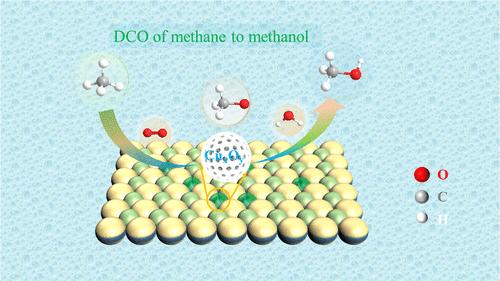当前位置:
X-MOL 学术
›
Ind. Eng. Chem. Res.
›
论文详情
Our official English website, www.x-mol.net, welcomes your feedback! (Note: you will need to create a separate account there.)
Preparation of Cu-Based Spherical Micromesoporous Material by Using Sepiolite Toward Methanol Production from Catalytic Oxidation of Low-Concentration Coalbed Methane
Industrial & Engineering Chemistry Research ( IF 4.2 ) Pub Date : 2024-04-10 , DOI: 10.1021/acs.iecr.3c04664 Yishuang Wang 1, 2 , Baolong Qin 1 , Mingqiang Chen 1, 2 , Defang Liang 1 , Zhiheng Lu 1 , Hairan Wang 1 , Chang Li 1 , Gang Yuan 1 , Jun Wang 1 , Liang Yuan 2, 3
Industrial & Engineering Chemistry Research ( IF 4.2 ) Pub Date : 2024-04-10 , DOI: 10.1021/acs.iecr.3c04664 Yishuang Wang 1, 2 , Baolong Qin 1 , Mingqiang Chen 1, 2 , Defang Liang 1 , Zhiheng Lu 1 , Hairan Wang 1 , Chang Li 1 , Gang Yuan 1 , Jun Wang 1 , Liang Yuan 2, 3
Affiliation

|
Direct catalytic oxidation (DCO) of coalbed methane to methanol has been considered as a significant technology for highly efficient and clean utilization of coal resources. Herein, the Cu-based spherical micromesoporous material (Cu/SMMM) was successfully prepared by using a sepiolite-derived silica source, and the DCO of methane to methanol was achieved under a low-temperature gas-phase system. Under the optimal reaction conditions, the Cu/SMMM accomplished the maximum methanol production of 69.3 μmol/gcat/h and methanol selectivity of 81.2% with full activation at 450 °C in air for 4 h, and the reaction was carried out at 320 °C for 1 h. Various characterizations demonstrated that the unique SMMM promoted the dispersion of copper oxides to form more active copper species and Lewis acidic sites (LAS). The variable-temperature FTIR, XAS, and NO-IR analyses identified that the highly dispersed dimeric copper species such as ([Cu2(μ-O)]2+ or [(Cu2O2)2+]) in Cu/SMMM was the major active species for DCO of methane into methanol. Additionally, combined with in situ FTIR analysis, the catalytic mechanism was revealed, in which the adsorbed methane species could be converted to CH3* species. Subsequently, CH3* species bound to oxygen of the dimeric copper species to form CH3O* species, which was then converted to methanol in the presence of water.
中文翻译:

海泡石制备铜基球形微介孔材料用于低浓度煤层气催化氧化制甲醇
煤层气直接催化氧化(DCO)制甲醇被认为是煤炭资源高效清洁利用的重要技术。在此,利用海泡石二氧化硅源成功制备了铜基球形微介孔材料(Cu/SMMM),并在低温气相体系下实现了甲烷到甲醇的DCO。在最佳反应条件下,Cu/SMMM在空气中450 ℃充分活化4 h,甲醇产量最大为69.3 μmol/g cat /h,甲醇选择性为81.2%,反应在320℃下进行。 °C 1 小时。各种表征表明,独特的 SMMM 促进了铜氧化物的分散,形成更活泼的铜物质和路易斯酸性位点 (LAS)。变温 FTIR、XAS 和 NO-IR 分析表明,Cu/ 中高度分散的二聚铜物质,例如 ([Cu 2 (μ-O)] 2+或 [(Cu 2 O 2 ) 2+ ]) SMMM是甲烷DCO转化为甲醇的主要活性物种。此外,结合原位FTIR分析,揭示了催化机制,其中吸附的甲烷物质可以转化为CH 3 * 物质。随后,CH 3 * 物质与二聚铜物质的氧结合形成CH 3 O* 物质,然后在水存在下将其转化为甲醇。
更新日期:2024-04-10
中文翻译:

海泡石制备铜基球形微介孔材料用于低浓度煤层气催化氧化制甲醇
煤层气直接催化氧化(DCO)制甲醇被认为是煤炭资源高效清洁利用的重要技术。在此,利用海泡石二氧化硅源成功制备了铜基球形微介孔材料(Cu/SMMM),并在低温气相体系下实现了甲烷到甲醇的DCO。在最佳反应条件下,Cu/SMMM在空气中450 ℃充分活化4 h,甲醇产量最大为69.3 μmol/g cat /h,甲醇选择性为81.2%,反应在320℃下进行。 °C 1 小时。各种表征表明,独特的 SMMM 促进了铜氧化物的分散,形成更活泼的铜物质和路易斯酸性位点 (LAS)。变温 FTIR、XAS 和 NO-IR 分析表明,Cu/ 中高度分散的二聚铜物质,例如 ([Cu 2 (μ-O)] 2+或 [(Cu 2 O 2 ) 2+ ]) SMMM是甲烷DCO转化为甲醇的主要活性物种。此外,结合原位FTIR分析,揭示了催化机制,其中吸附的甲烷物质可以转化为CH 3 * 物质。随后,CH 3 * 物质与二聚铜物质的氧结合形成CH 3 O* 物质,然后在水存在下将其转化为甲醇。



























 京公网安备 11010802027423号
京公网安备 11010802027423号